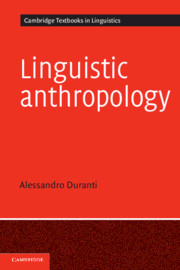Book contents
- Frontmatter
- Contents
- Preface
- Acknowledgments
- 1 The scope of linguistic anthropology
- 2 Theories of culture
- 3 Linguistic diversity
- 4 Ethnographic methods
- 5 Transcription: from writing to digitized images
- 6 Meaning in linguistic forms
- 7 Speaking as social action
- 8 Conversational exchanges
- 9 Units of participation
- 10 Conclusions
- Appendix: Practical tips on recording interaction
- References
- Name index
- Subject index
2 - Theories of culture
Published online by Cambridge University Press: 05 June 2012
- Frontmatter
- Contents
- Preface
- Acknowledgments
- 1 The scope of linguistic anthropology
- 2 Theories of culture
- 3 Linguistic diversity
- 4 Ethnographic methods
- 5 Transcription: from writing to digitized images
- 6 Meaning in linguistic forms
- 7 Speaking as social action
- 8 Conversational exchanges
- 9 Units of participation
- 10 Conclusions
- Appendix: Practical tips on recording interaction
- References
- Name index
- Subject index
Summary
If the premise of linguistic anthropology is that language must be understood as cultural practice, our discussion of the field must include a discussion of the notion of culture. This task is particularly challenging at the moment. Never before has the concept of culture been so harshly scrutinized and attacked from all sides. In recent years, the concept of culture has been criticized as an all-encompassing notion that can reduce sociohistorical complexities to simple characterizations and hide the moral and social contradictions that exist within and across communities. Many social scientists – including some anthropologists – have argued that the notion of culture is so identified with a colonialist agenda of intellectual, military, and political supremacy on the part of western powers toward the rest of the world that it cannot be used without assuming a series of naive and misleading dichotomies such as “us” and “them,” “civilized” and “primitive,” “rational” and “irrational,” “literate” and “illiterate,” and so on. “Culture” is what “others” have, what makes them and keeps them different, separate from us. In the nineteenth century culture was a concept used by Europeans to explain the customs of the people in the territories they came to conquer and populate (in Africa, North and South America, Australia, the Pacific Islands, Asia). Today, culture is used to explain why minorities and marginalized groups do not easily assimilate or merge into the mainstream of society.
- Type
- Chapter
- Information
- Linguistic Anthropology , pp. 23 - 50Publisher: Cambridge University PressPrint publication year: 1997
- 1
- Cited by

